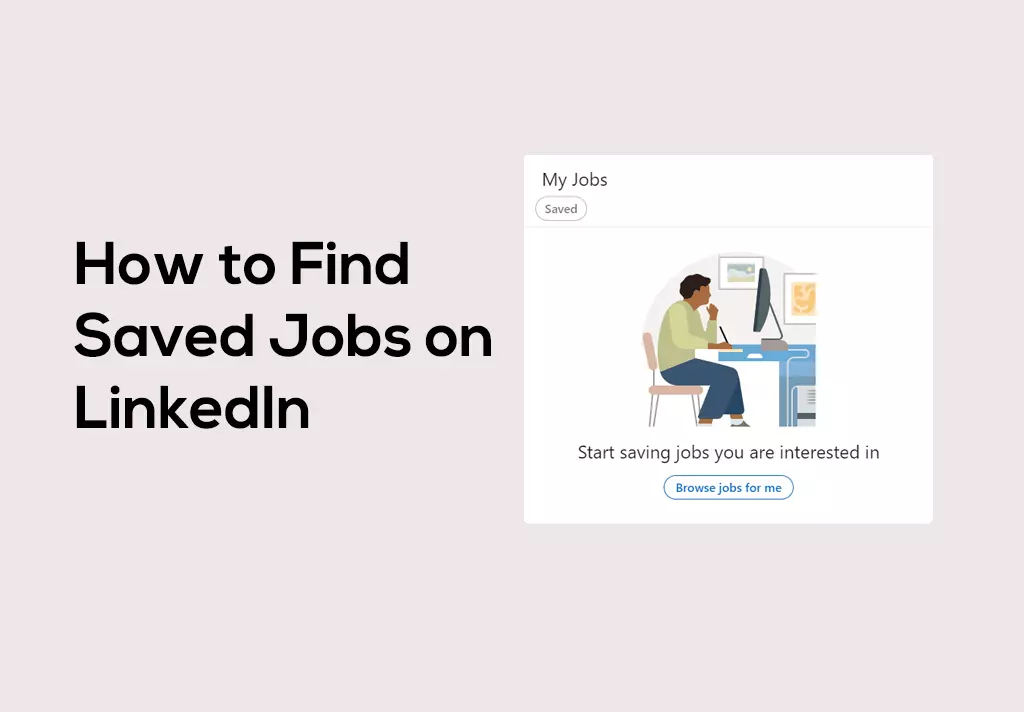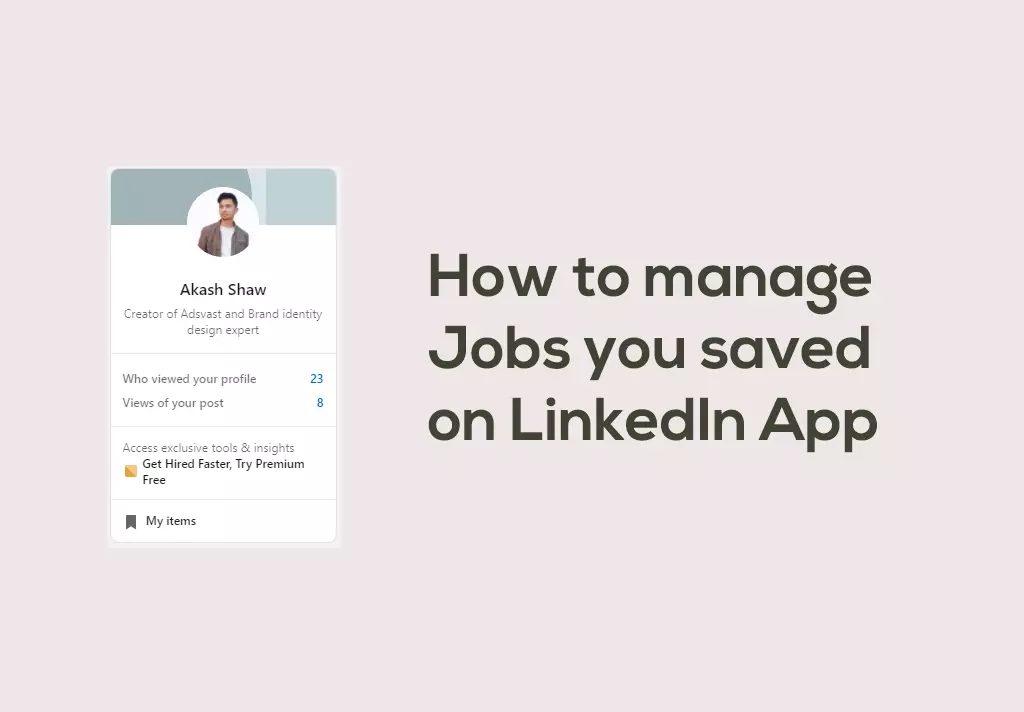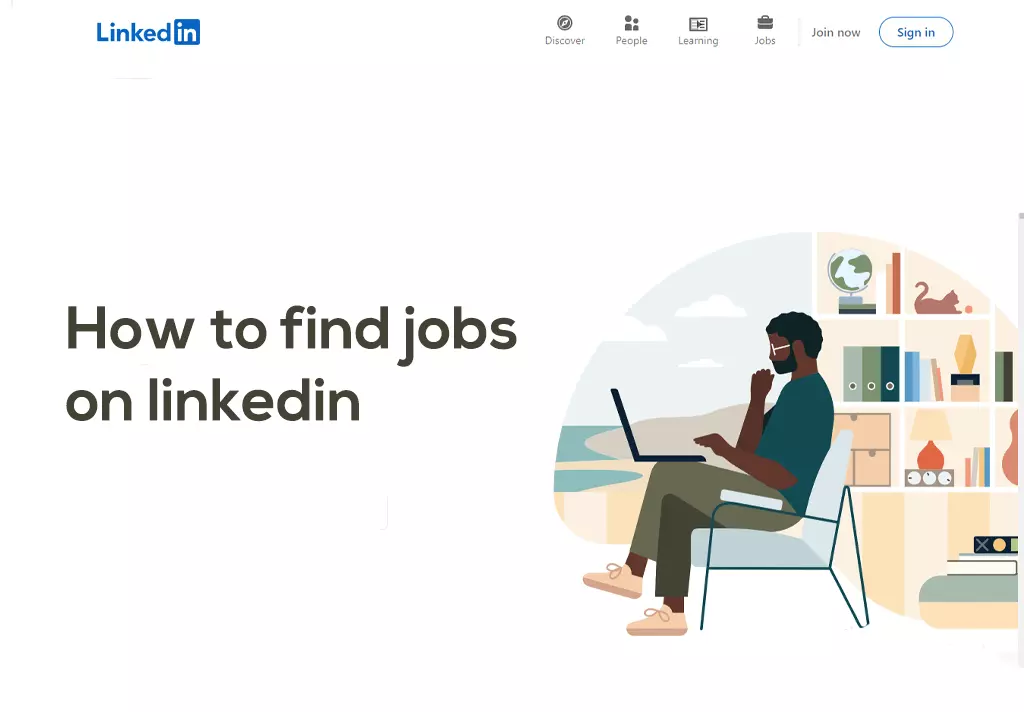LinkedIn is an American-based employment-oriented and career development online service that operates via mobile apps and websites. The Linkedin platform is primarily for career development and professional networking. Linkedin allows freelancers and job seekers to post their resumes and apply for jobs.
Employers to post about employment and hire employees for their company. As of September 2021, LinkedIn has around 775+ million registered members from about 200 countries. So, how to Find Saved Jobs on LinkedIn?
Since its official launch, it has been a great help and boost in the business sector. LinkedIn has helped companies and startups to hire employees and freelancers for their companies efficiently.
It also has a feed section where people can share their views, thoughts, and ideas via text or posts. The feed helps other users to get inspired by others’ ideas, reviews, and opinions.
Linkedin is a perfect platform to groom yourself in your career and learn from others.
It allows its members to create their profiles and connect in an online social network. Members can invite anyone to become their “connection.”
The connections help you improve your profile and create a page you need connections.
You may use LinkedIn to organize events, write articles, join groups, publish job postings, post photos, videos, etc.
Another advantage of LinkedIn is various options for job seekers and employers. Those seeking a job can see many options regarding where they want to work.
How to find jobs on linkedin

1. First Thing First:
Build a findable and compelling profile. Your profile is the main thing you should focus on building. You can put up many things on your Linkedin profile that you can not write in your CV.
2. Build a network.
Grow your LinkedIn network by sending personalized LinkedIn connection requests to everyone you know. From — Working professionals, HR and senior executives in the companies you look forward to, friends, family, neighbors, teachers, colleagues, classmates, and more.
3. Become an expert.
Check out LinkedIn news dashboard and Influencer posts for the top daily headlines, join Groups, and follow new industry-specific “Channels.”
4. Have a noticeable headline.
Get your profile noticed by people. Write a concise but descriptive
a headline like “XYZ University honors student & aspiring PR associate,” “Entry-level creative professional,” or “Finance major seeking investment banking internship.”
5. Include keywords.
Recruiters search LinkedIn for candidates. Use the keywords. Find keywords from the job descriptions you’re going after.
6. Take advantage of student profile sections.
Complete the profile sections designed primarily for students, such as Courses, Projects, Languages, Certifications, and Organizations. Keywords are good here too. Complete profiles get 40x more opportunities!
7. Talk about all your relevant experiences.
Experience doesn’t always have to be paid or full-time on your profile. It can include internships, part-time jobs, extracurriculars, volunteer work, projects, etc., that have given you real-world skills.
8. Ask your network for help.
70% of jobs are founded through your network. Once you connect, send customized messages to say you’re job-hunting. Ask for advice, an interview, or if they know anyone in your desired field. Connect one-on-one, and others will be willing to make an effort for you.
9. Find “ins” where you want to work.
10. Search the Student Jobs Portal.
The Student Jobs Portal is just for you: It has all the entry-level job and internship postings on LinkedIn. Search by job role or review postings from featured companies. Apply for positions, and the employer will see your entire LinkedIn profile.
11. Get gutsy.
Don’t be afraid to reach out directly to a recruiter on LinkedIn. One strategy is to apply to a position you want and send a message to the recruiter who posted the opportunity.
How to manage Jobs you saved on LinkedIn App

To access your saved jobs on the LinkedIn mobile app:
- Tap the Jobs icon.
- Tap Saved jobs under the search bar.
- Under the Jobs tab, tap the job you desire to access.
Where To Find Saved Jobs In LinkedIn
Accessing jobs you’ve saved on the LinkedIn desktop site:
- Log in to LinkedIn: Login or Signup.
- Click on Jobs at the top of your homepage.
- Then lick Track my jobs above the search bar at the top of the page.
- Any jobs you’ve saved are listed in Saved jobs. Click on a job to view the details and begin the application process.
Why I can’t find saved jobs on the linkedin app
Follow these steps first:
- Tap the Jobs icon.
- Tap Saved jobs under the search bar.
- Under the Jobs tab, tap the job you desire to access.
If you cannot see that saved job, you probably have not kept it correctly.
Or maybe that company had removed that job listing.
Also Read: How to scrape and collect data from LinkedIn [2022]
Tips To Manage Your LinkedIn Saved Jobs
Optimized LinkedIn Profile
We mean optimized, similar to how a website is optimized on Google search when we say optimized.
What are the components?
Profile Picture (Showing your face)
Cover Photo (Depends on what you want to achieve through LinkedIn, i.e., build a personal brand, generate leads or find a new job.)
Location
Assuming your profile is optimized till here. The next step is to add connections, but the catch here is to add relevant people only until a particular point in time. Why? We’ll get there soon.
Add Relevant Connections
What are relevant connections, and who are they?
Once your Objective has been established, you need to ask yourself who you target. Students? Professionals? Recruiters? and many more.
The age-old “add as many as you can” advice is applicable.
This technique applies if you’re using LinkedIn in your spare time to show companies that you have a LinkedIn profile.
But if you’re serious, then consider adding only people from your target audience along with your friends, workmates from previous organizations, etc. This relevancy is only applicable to new connections of whom you’re unaware. How will this benefit someone like you when your friend adds as many as possible? That’s where Content comes into the picture.
Content Growth
The LinkedIn algorithm works in such a way that if you put out a piece of Content, it will be shown to a small set of your connections. LinkedIn feels it valuable if they engage with it and offer it to more people.
Let’s say, as an example, you’re a digital marketer. Out of all your connections, only 5% are digital marketers. The rest are friends, colleagues, random people you don’t know but added because you felt they would be helpful in the future. Now, you have written a piece on the latest digital marketing trends.
Linkedin would first show the post to a small set of people. And depending on their engagement levels, it would be decided if the post dies down or becomes famous, in a way.
The problem here is that only 5% of your connections can understand and relate to your Content. There’s a high chance that the rest of the people won’t know what you’re trying to say. And this is where relevancy comes into the picture.
Content Creation
For your Content to grow, you need to create Content. Content can be stories of yourself, your opinions on ongoing trends, case studies but three things to keep in mind to see steady growth:
- Quality over quantity
- Consistency is the key.
- Results take time. So, be patient.
Engagement
As much as it is essential to build your profile by producing Content, engaging with other people in your network is vital. Engaging helps you to establish a relationship with the other person. If your comment (one way to engage) stands out, people start looking at your profile. If it is well optimized, as said in the first point, they would want to look at your posts and articles that you’ve created and would like to engage. When they hire, their connections can see the engagement, and the chain reaction continues.
How to delete all saved jobs on linkedin
Deleting jobs you’ve saved on the LinkedIn desktop site:
- Log in to LinkedIn: Login or Signup.
- Click on Jobs at the top of your homepage.
- Then Click Track my jobs above the search bar at the top of the page.
- Any jobs you’ve saved are listed in Saved jobs. Click on a job to view the details and begin the application process.
- Click the job and click the ‘Unsave’ button found at the top of the job details page.
To delete your saved jobs on the LinkedIn mobile app;
- Tap the Jobs icon.
- Tap Saved jobs under the search bar.
- Under the Jobs tab, tap the job you desire to access.
- Next, Tap the More icon next to the job, which appears as three vertically aligned dots. Once there, find the ‘Unsave This Job’ button, and tap it.
How to job search on linkedin
If you’re a job seeker trying to use LinkedIn to find a job, you might think that using the “Apply Now,” or Easy Apply feature is your best bet. Is it fast and efficient right? The problem with that approach is that everyone does the same thing since it is so easy.
So it’s hard for you to stand out as a job seeker on LinkedIn, Or perhaps you KNOW you need to network on LinkedIn to find a job you want.
Still, you’re not sure where to start—the best way to engage with active LinkedIn users, who usually have a vast network already.
First, do this by finding out where the active users are and commenting on their posts. Rinse and repeat for 2-4 weeks, and we promise you will make progress on your job search journey.
After you have engaged and hopefully re-engaged these active LinkedIn users, you want to follow up and send connection requests that get accepted.
I highly recommend Austin Belcak’s 3-step LinkedIn Connection Request formula since it’s simple and effective. First, lead with positivity, then show them you’ve done your homework. And finally, ask them a genuine question, so they feel like you’re seeking guidance from them.
Search Tips:
Alumni Search:
Let’s say that you want a more relevant job to your schooling. You can go to linkedin com/alumni to get a list of what other alumni are doing. That way, you can sort it by skill, by job title, and see what they’re doing. Although I find it can be an excellent exercise to scroll through everyone to know if you find things off your beaten path.
Advanced Search:
So maybe your schooling isn’t what makes you relevant. This is where advanced search can come into play, searching for keywords or years of experience and then looking at people’s profiles.
Groups:
Join groups related to what you’d like to do, and then ask a more specific variation of this question. “I’m looking for development jobs, but I’m having trouble finding roles that are more relevant to someone with only two years of experience. Does anyone have any advice? I’d also love anecdotes since you’re working in the industry where I’d like to work.”
Informational Interviews:
Maybe you’re unsure if you’d like to post in a group because you don’t know how to change your settings, so your current boss will see it. You can always invite someone to connect and ask them for advice on finding the right kind of workplace.
Top Tips on Using LinkedIn to Land a Job
Yes, LinkedIn does help get a job, and not straightforwardly. Still, if you use it smartly, you can get Interview opportunities.
- Be Active on LinkedIn as much as you can, keeping refreshing it every half an hour.
- Building Connection – start connecting to the people of your industry and specialization, especially the HR folks.
- Post Liking – This is a very underrated point. Whenever an HR person puts in a post, like it as soon as possible.
- Cold Emailing – Cold email your resume to potential HR in their outlook id. Most of the emails end with “companyname.com.”
- LinkedIn Profile – Keep it top-notch. In the description, put your p.y job responsibilities or internship.
- Preparation – Whenever you get an opportunity, be very well prepared. Research about the company, whatever the company wants from you justify it to the Interviewer.
- Unpaid Internships are the best for Freshers.
FAQs
How to delete all saved jobs on linkedin
Deleting jobs you’ve saved on the LinkedIn desktop site:
- Log in to LinkedIn: Login or Signup.
- Click on Jobs at the top of your homepage.
- Click Track my jobs above the search bar at the top of the page.
- Any jobs you’ve saved are listed in Saved jobs. Click on a job to view the details and begin the application process.
- Click the job and click the ‘Unsave’ button found at the top of the job details page.
To delete your saved jobs on the LinkedIn mobile app;
- Tap the Jobs icon.
- Tap Saved jobs under the search bar.
- Under the Jobs tab, tap the job you desire to access.
- Next, tap the More icon next to the job, which appears as three vertically aligned dots. Once there, find the ‘Unsave This Job’ button, and tap it.
What happens when you save a job on linkedin
Saving the jobs means nothing to the recruiter. They can’t see anything. It’s 100% a tool that lets you remember to apply later.
They can see how many people have seen the job posting, but most recruiters are too busy to look at that data. They have too many sources to consider. Mostly they look at the ATS to see who’s applied (unless they are a source, in which case, they are searching sites with keywords to find the right fit).
Can anyone see my saved jobs on linkedin?
Not only can you see your saved jobs.No one else can see that except you – it is for you as a potential Job Seeker to review jobs you’ve “saved.”
So, this was our blog about Linked jobs. We have discussed tips on getting a job, saving and unsave, and maintaining job listings on LinkedIn.
Hope this has helped you and solved all your queries and issues. We will be glad to receive comments with your thoughts about this article.
ThankYou!
keep the conversation going

Hi, i’m Akash shaw creator of Adsvast agency , Hello, I am a perfectionist with deep love for aesthetics,
a graphics designer with expertise in logo design and branding.
My only goal with Notamartwork is try to help others to freelancers to get jobs and learn how to do freelancing.

2 thoughts on “How to Find Saved Jobs on LinkedIn”